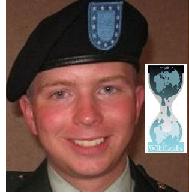Manning - Wikileaks
Evidence shows Bradley Manning links to Wikileaks
 Prosecutors in Bradley Manning's pre-trial hearing today provided the first evidence linking the Army private accused of leaking hundreds of thousands of classified documents with Wikileaks and the site's founder, Julian Assange.
Prosecutors in Bradley Manning's pre-trial hearing today provided the first evidence linking the Army private accused of leaking hundreds of thousands of classified documents with Wikileaks and the site's founder, Julian Assange.
Army investigators said they had found Assange's name on Manning's personal computer, an email in which Manning claimed to have leaked a video to the site and a message in which he boasted that hundreds of thousands of military battlefield reports from Iraq and Afghanistan were "possibly one of the more significant documents of our time, removing the fog of war and revealing the true nature of 21st century asymmetric warfare."
In 2010, Wikileaks, published hundreds of thousands of military battlefield reports from Iraq and Afghanistan, as well as more than a hundred thousand State Department cables.
Army Special Agent David Shaver testified today that a review of the data card Manning used with two secure computers he used in Baghdad contained hundreds of thousands of battlefield reports from Iraq and Afghanistan.
Shaver said he found the reports in an encrypted file after using the password "TWink1492!!" which was also the log-in for Manning's personal computer. He agreed with the prosecution when they said, "So you got kind of lucky."
Upon accessing the file, Shaver said, he found 91,000 Afghanistan battlefield reports and more than 400,000 similar reports from Iraq.
He also found a small text file that referred to the reports as being "Iraq and Afghanistan significant activities (SIGACTS) between 000001 on 31-jan 2004 and 23:59 am on 31 Dec 2009." Presumably the note was intended for Wikileaks and recommended sitting on the information "for 90-180 days to figure out how best to send and distribute such a large amount of data and to a large audience and protect the source."
It closed, "File is possibly one of the most significant documents of our time, removing the fog of war and revealing the true nature of 21st century asymmetric warfare."
Mark Johnson, a computer forensic analyst working for the Army, said he had reviewed Manning's personal computer for instant messaging and Internet chat logs.
His search recovered a buddy list that included a contact for Adrian Lamo, the hacker who notified federal authorities about Manning's boasts of transferring thousands of classified documents.
The list also contained the email address [email protected] that was found to be associated with aliases for both Assange and Nathaniel Frank. Johnson stated that it was "unusual to find two different aliases" assigned to one email address.
From the computer's deleted files Johnson said he was able to recover 14 to 16 pages of chat logs between Manning and the alias Nathaniel that dealt predominantly with the sending of government information, but also mentioned Wikileaks.
When asked if he believed from these chats that the two parties knew each other Johnson responded, "They talked about 'did you receive information'" and it appeared they "had known each other in the past."
A second email address, [email protected], was also found to be an alias for Assange.
Wikileaks was also a topic of discussion in a number of encrypted and unencrypted emails between Manning and an acquaintance, Eric Schmiedl. In a May 19, 2010, email, Manning wrote, "I was the source of the 12 July 07 video from the Apache Weapons team. Which killed the two journalists and injured two kids." Wikileaks had posted the video on the internet in April 2010
Johnson also said he had recovered computer data that indicated Manning had uploaded materials from his personal computer to the Wikileaks website.
Additional archived information found on the computer indicated he had documents "clearly marked classified or secret." Johnson also found that the laptop had been erased in early January 2010.
"Everything from early January is gone. Permanently erased or replaced with zeros … all of the unallocated space we are examining occurred (after) that date," Johnson said.
Johnson also examined Manning's external hard drive, which contained contact information, a November 2009 text file with a phone number for "24 hour service, Ask for 'Julian Assange.'"
(Published by ABC News - December 19, 2011)